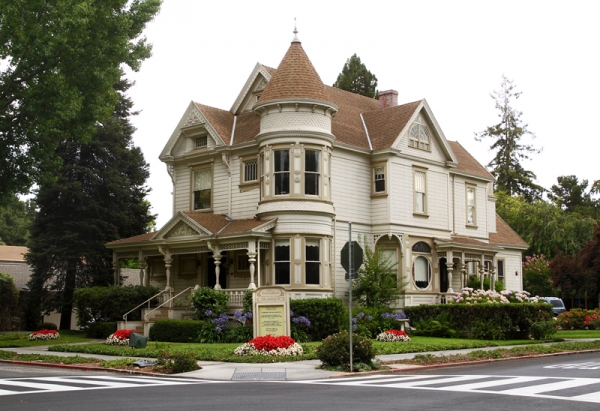Santa Barbara has its Spanish villas and San Francisco has its postcard-perfect Victorians, but Palo Alto's architecture is a hodgepodge of styles.
The Queen Annes came first, their corner towers and flamboyant gables perching atop the spacious manors of Emerson, Waverley and Cowper streets in the last decade of the 19th century. Loaded with carved pilasters, columns and ornamental railings, these cutting-edge Victorians made no pretense of humility. As the newly formed city of Palo Alto began to take shape in the mid- and late-1890s, the Queen Annes were the fashionable choice for Stanford University fraternity houses and well-to-do pioneers looking to pitch extravagant tents in the new frontier.
The Shingle style, which also made its debut during Palo Alto's earliest years, was far more modest but no less popular. Found all over the Professorville neighborhood, these homes embraced the Craftsman style, according to Ward Winslow's "Palo Alto: A Centennial History," a movement in which "natural materials and continuity between indoors and out are emphasized." These hardy cottages greeted visitors with broad, continuous faces, exposed timbers and redwood paneling. They took pains to live in harmony with their surroundings.
Classical Revival houses, with their formal symmetry, Palladian windows and Greco-Roman columns, also began to pop up around Professorville around that time, according to Winslow. So did houses in the ornate Colonial Revival style, with their rectangular facades, regal pilasters and gabled roofs. This was the style of choice for Palo Alto's first apartment complex, a two-story building at 626-631 Emerson St.
All of these styles are displayed prominently in the "Palo Alto Live Oak," an early periodical that includes in its June 1903 issue a photo spread of manors owned by some of the city's most prominent pioneers. Critics today may bemoan the decline of "traditional" architecture and lack of compatibility between old and new buildings, but if there's one thing that the Live Oak makes clear it's that the city's architecture has never been homogenous.
The one style that many associate with Palo Alto today is the Spanish Colonial Revival (or Early California) look championed by Birge Clark, the only architect who had an office in Palo Alto between 1922 and 1930. Winslow refers to Clark as the "chief architect and shaper of the community" and notes that he is "cited frequently as having helped to establish the image of the community." Clark designed a total of 98 residences in Palo Alto and 39 homes on the Stanford campus, most of them distinguished by Spanish-style features such as arcades, red-tiled roofs, stucco walls and wrought-iron grilles. Some of the city's most iconic public buildings, including the U.S. Post Office on Hamilton Avenue, the sprawling Lucie Stern Community Center on Middlefield Road and some buildings on the historic block on Ramona Street, south of University Avenue, were designed by Clark.
"If you can describe pure heaven, he was in it -- a growing university town, and he was the only architect here," said architect John Northway, who worked with Clark and studied under him at Stanford and whose family was close to Clark's.
It didn't hurt that Clark had strong allies and benefactors. Stern commissioned him to build the community center that today bears her name. Another long-time acquaintance, First Lady Lou Henry Hoover, personally intervened to help Clark overcome initial opposition from Washington, D.C., bureaucrats to his proposed design for the Palo Alto post office.
"The post office was a radical building for its time," Northway said. "Now, it's a poster child for 'Why can't all architecture look this way?"
But Clark's legacy and output notwithstanding, the idea that Palo Alto has a particular "established image," is shaky at its foundations. From the early Queen Annes and classical Italianate style homes to the eight-story monolith that is Palo Alto's City Hall, diversity in styles has always been the rule. Anyone driving through the Eichler communities of Fairmeadow, Greenmeadow or Palo Verde -- where minimalist, one-story buildings with glassy sliding doors conspicuously reject Spanish flourishes -- might reasonably be shocked to hear that Palo Alto is a city with a "traditional" style or (as Winslow put it) the "city that Birge built."



Comments